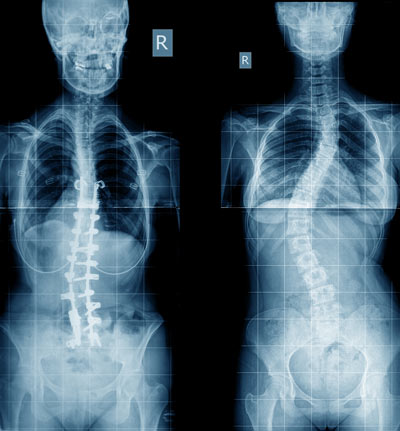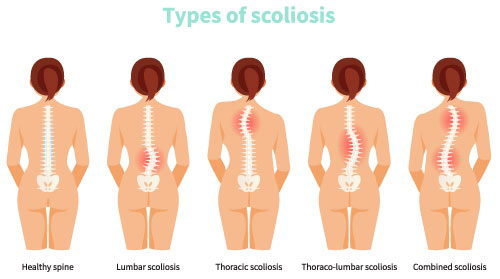Scoliosis, an abnormal sideways (lateral) curvature of the spine, is typically diagnosed between ages 10-16 and is more common in girls than boys. While a normal spine has an S-shaped curvature (fore and aft) it is not normal for the spine to also bend from side-to-side.
Even if the lateral curvature is minimal, when it is left untreated as a child it can grow into multiple health problems as an adult. Scoliosis will put undue stress of the spinal column and lead to spinal osteoarthritis and other degenerative disc diseases. In addition to spinal degeneration, your body will try to compensate for being out of balance, which often leads to unlevel hips. This can lead to degeneration problems in the hip such as arthritis in the hips. Over time, the degenerative problems caused by scoliosis will lead to nerve interference to your vital organs and muscles. These problems can include:
- Breathing problems
- Heart problems
- Acid reflux
- Digestive problems
- Incontinence
- Constipation
- Spinal stenosis
- Infertility
- Sciatica
- And other conditions
Adult scoliosis can also create balance problems and will reduce the individual’s height because the spinal misalignment of scoliosis twists the body and decreases stature. Additionally, scoliosis can cause pain and weakness in the buttocks, legs, and feet due to compression (pressure) of the sciatic nerve.
4 Types of Scoliosis:
- Congenital scoliosis.
Present at birth and is caused by a bone abnormality. - Degenerative scoliosis.
This results from a traumatic injury, osteoporosis (or thinning of the spinal bones), bone deformation or collapse, or major spinal surgery. - Idiopathic scoliosis.
This is the most prevalent form of scoliosis (80% of cases) and there is no known cause for it. There are various theories but none are conclusive. However, it is known to run in families. - Neuromuscular scoliosis.
The result of abnormal muscle or nerve formation. This type of scoliosis is frequently seen with those with spina bifida or cerebral palsy.
Treating Scoliosis
Orthopedic and traditional medical approaches to treating scoliosis depend on the measurement of scoliosis curvature. Treatments can range from simply “watching” to see if it gets worse; stretches and rehab if the curvature is less than 25º; wearing a back brace if the child is still growing and the curvature measures between 25–40º; to surgery with spinal fusion and the insertion of metal rods if the curvature is over 40º and has not responded to the back brace.
As you can imagine, no one reacts well to being asked to wear a back brace for 23 hours a day, 7 days per week — especially children. Surgery, which should only be a last resort, brings risks and will cause additional problems over the years as it will permanently reduce your range of motion and flexibility. Whenever there is any fusion of spinal vertebrae, it will put additional stress on the rest of the spine.

Chiropractic Care and Scoliosis
Chiropractic care is a proven way to successfully treat scoliosis. Chiropractors will use chiropractic adjustments to realign the spine, removing pressure from the nervous system and increasing range of motion throughout the spine. Chiropractors will also prescribe postural and rehabilitative exercises in conjunction with adjustments to strengthen and stabilize the muscles surrounding the spine.
Chiropractic care has been shown through numerous case studies to be effective at treating scoliosis. In one case from 2010, a 15-year-old girl with a 44-degree curve began chiropractic treatments for scoliosis. After 5 months, her curve had reduced from 44 to 32 degrees and she continued to show further signs of progress.
People with Scoliosis Should Seek Chiropractic Care
Scoliosis affects between 5-7 million people in America, and most of these are children. 80% of individuals with scoliosis have less than a 20º curvature — often it requires a trained eye to notice it — and would typically only be treated with “careful observation” (may include stretching and rehab exercises) by the traditional medical community. The reason for the passive treatment is simple — nobody wants to wear a back brace.
Chiropractic care, on the other hand, offers a pro-active way to treat and correct scoliosis. Once the lateral curvature is less than 10º it is no longer considered scoliosis. This is a much better solution than the “wait and see if it gets worse” approach. Proper chiropractic care and treatment can save you from having to wear a body brace and avoid surgery.
How can you tell if you have scoliosis?
Your body gives you clues: one shoulder may be higher than the other, one hip could be higher than the other, perhaps the head is not carried directly over the pelvis, a prominent shoulder blade, or maybe the entire body is leaning to one side. A chiropractor can give a postural exam to help identify scoliosis.
If you are looking for alternatives to medications and surgeries for scoliosis and many other health concerns, please contact Tuckahoe Family Chiropractic at 804.740.3434, and arrange for a consultation. You can also use our convenient appointment form. If you know of others who can benefit from this article, please share and recommend this article.

